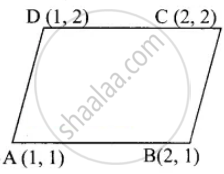Advertisements
Advertisements
Question
Verify that the following points taken in order to form the vertices of a rhombus
A(1, 1), B(2, 1), C(2, 2) and D(1, 2)
Solution

Distance = `sqrt((x_2 - x_1)^2 + (y_2 - y_1)^2`
AB = `sqrt((2 - 1)^2 + (1 - 1)^2`
= `sqrt((1)^2 + (0)^2`
= `sqrt(1)`
= 1
BC = `sqrt((2 - 2)^2 + (2 - 1)^2`
= `sqrt((0)^2 + (1)^2`
= `sqrt(1)`
= 1
CD = `sqrt((1 - 2)^2 + (2 - 2)^2`
= `sqrt((- 1)^2 + (0)^2`
= `sqrt(1)`
= 1
AD = `sqrt((1 - 1)^2 + (2 - 1)^2`
= `sqrt((0)^2 + (1)^2`
= `sqrt(1)`
= 1
AB = BC = CD = AD = 1.
All the four sides are equal.
∴ ABCD is a rhombus.
APPEARS IN
RELATED QUESTIONS
If the co-ordinate of A is x and that of B is y, find d(A, B).
x = 6, y = - 2
Find d(A, B), if co-ordinates of A and B are -2 and 5 respectively.
On a number line, the co-ordinates of P, Q, R are 3, -5 and 6 respectively. State with reason whether the following statement is true or false.
d(R, P) + d(P, Q) = d(R, Q)
Co-ordinates of the pair of a point is given below. Hence find the distance between the pair.
3, 6
Co-ordinates of the pair of points are given below. Hence find the distance between the pair.
x + 3, x - 3
Co-ordinates of the pair of points are given below. Hence find the distance between the pair.
80, - 85
Find the distance between the following pair of points
(3, 4) and (−7, 2)
Determine whether the given set of points are collinear or not
(7, −2), (5, 1), (3, 4)
Show that the point (11, 2) is the centre of the circle passing through the points (1, 2), (3, −4) and (5, −6)
Find the distance with the help of the number line given below.

d(P, C)
